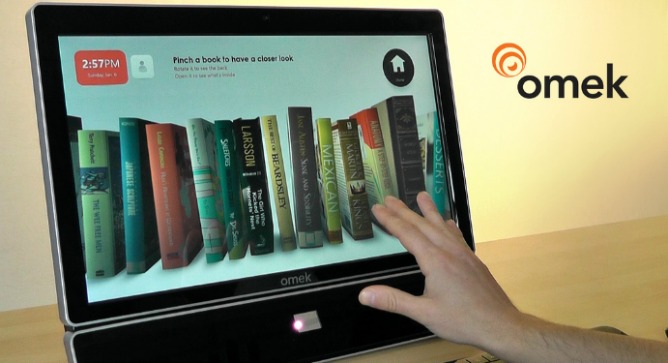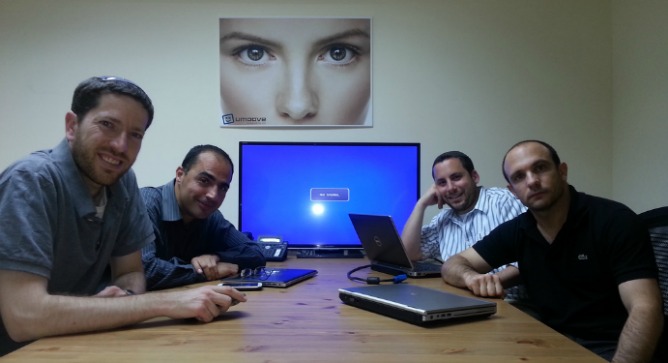If you’re watching a movie on your laptop and the phone rings, why shouldn’t the computer automatically pause the film while you pick up the call? If you’re driving and another car is drifting into your lane, why shouldn’t you be able to activate the horn simply by shaking your fist?
Israel’s Omek Interactive was founded to make these scenarios – and multitudes more – possible with cutting-edge computer vision software that allows you to control everything without touching anything.
Spread the Word
• Email this article to friends or colleagues
• Share this article on Facebook or Twitter
• Write about and link to this article on your blog
• Local relevancy? Send this article to your local press
We’re not talking about yet another device to learn how to operate, but an optical “brain” that lets you interact naturally with your existing devices — from computers to cameras to cars.
“Instead of continuing to add peripheral devices in order to advance in the PC industry,” says founder and CEO Janine Kutliroff, “we’re saying, ‘Stop with the add-on devices.’ We want to let you interact in a much more natural way, by enabling your computer to understand you the way people do. We created this intelligence to enable true innovation.”
Kutliroff and her husband, Gershom, launched Omek in 2007. The company’s full-body-tracking software was incorporated not long afterward into the Chinese-made motion gaming console Eedoo. Now its proprietary software comes bundled with every Panasonic 3D camera sold.
“Gaming was the low-hanging fruit in the living room, but it’s so much broader than gaming,” Kutliroff tells ISRAEL21c. “We are offering the ability to manipulate images not just for fun but to extend the usability of your personal computing device.”
A whole new level of interaction
Omek’s Grasp product follows the movement of 22 points along each hand and fingers. “That allows for whole new level of interaction,” Kutliroff says.
While companies such as Leap Motion make motion-control devices based on 10-point finger recognition, she adds, “our software tracks every joint on the human hand, giving developers the ability to do anything with that information, as complex as they want.”
Kutliroff reports that Omek’s suite at the all-important Consumer Electronics Show (CES) in January in Las Vegas was mobbed with PC OEMs (original equipment manufacturers) and ODMs (original design manufacturers) seeking intuitive human-machine interfaces.
The Sunday Times of London informed readers that in a few years their car’s entertainment and navigation systems could be controlled with gestures — thanks to the Israeli company’s ability to build a 3D model of the hand through tiny dashboard-mounted digital cameras, tracking each joint’s movement dozens of times per second in daylight or darkness.
“The automotive market follows trends in consumer electronics, because as people get comfortable with the use of new devices, they want that experience to follow them into their cars,” Kutliroff explains.
Automotive execs approached Omek last year in search of close-range gesture recognition to accomplish touch-free tasks without taking one’s eyes off the road. The company is preparing demos for some of the top brands to show off at upcoming auto shows.
“Once this new generation of cameras starts getting implemented in cars, you can know and do more, such as seeing where the driver’s head is looking and perhaps sending an alert if he’s nodding off. This is only possible with a very robust technology,” says Kutliroff. “The tracking technology needs to be close to 100 percent accurate.”
3D camera is key
Cars of the future aside, Omek is focusing mainly on the personal computing market. Having secured three rounds of financing, the last led by Intel Capital, the privately held company currently is seeking $10 million.
“There’s still R&D work to do in order to maintain our leadership position in the technology and marketing work necessary to have the right positioning,” explains Kutliroff, who heads a staff of 42 working in Beit Shemesh and in Taipei, Taiwan. “We want to make sure our product is in every PC and eventually in every tablet.”
Her confidence comes from a successful corporate background. In the mid-1990s, Kutliroff helped telecommunications firm IDT launch its revolutionary Net2Phone Voice over Internet Protocol (VoIP) division. At the same time, her husband went back to school for an advanced degree in computer vision.
“After his PhD, he really wanted to move to Israel, and IDT offered me the opportunity to start another company for them here in Israel,” Kutliroff relates. While she was growing IDT’s now-defunct Jerusalem call center operation to its peak of nearly 1,000 employees, Gershom’s work in computer vision eventually led to the idea of building software for 3D cameras.
“He thought computer vision was the wave of the future, though the field’s advancement had been slow because of the input devices, namely conventional RGB cameras. He believed that 3D cameras would revolutionize the industry,” says Kutliroff.
His enthusiasm rubbed off on his wife, and they started Omek together in 2007. The company has since acquired a large body of proprietary and patented intellectual property.
“What we do is software only,” she stresses. “Like the human brain, our software infers about what it cannot see.”
The next stop for Omek is proposing products for the international device manufacturers who will be at the Computex show in Taiwan this June.
















